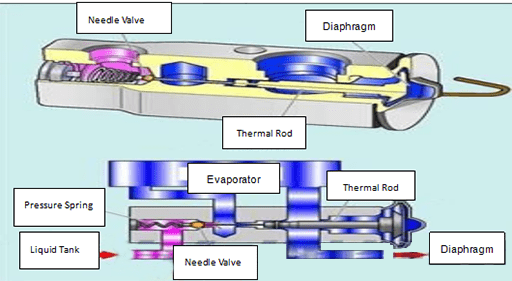
Figure 1: An expansion valve.
The expansion valve is installed at the inlet of the evaporator. Its function is to eject the high-temperature and high-pressure liquid refrigerant from the receiver dryer from the small hole of the expansion valve. So, it can reduce the pressure, expand the volume, convert it into mist refrigerant, absorb heat in the evaporator and turn it into gaseous refrigerant. At the same time, the refrigerant flow can be adjusted according to the refrigeration load to ensure that all the refrigerant at the outlet of the evaporator is converted into gas.
1.How Thermostatic Expansion Valve Work

Figure 2: How Thermostatic Expansion Valve work.
The sensing bulb fixed on the air return pipeline is equipped with inert liquid as refrigerant. When the outlet temperature of the evaporator is high, the liquid temperature in the sensing bulb will rise and the internal pressure will rise. When the pressure acting on the diaphragm is greater than the sum of the inlet pressure of the evaporator and the superheat spring, the needle valve leaves the valve seat, the valve opens and the refrigerant flows into the evaporator.
After the needle valve is opened, the refrigerant enters the evaporator, the pressure in the evaporator rises, the return air temperature decreases.And then the pressure on the lower side of the diaphragm increases, the pressure on the upper side decreases, and the valve is closed.Because the pressure on the upper and lower sides of the diaphragm is often in an unbalanced state, it will be in a continual process of opening and closing.
2.Types and Working Principles of Expansion Valves
There are three structural forms of Expansion valve, namely External balance expansion valve, Internal balance expansion valve and H block expansion valve, which are introduced below.
2.1 External Balance Expansion Valve
The structure of external balance expansion valve is shown in the figure. The inlet of the expansion valve is connected to the receiver dryer and the outlet is connected to the evaporator. There is a diaphragm on the upper part of the expansion valve, and a sensing bulb is connected above the diaphragm through a thin pipe. The sensing bulb is installed on the pipeline at the outlet of the evaporator and filled with refrigerant gas. When the temperature at the evaporator outlet changes, the gas volume in the sensing bulb will also change resulting in a pressure change.It acts on the top of the diaphragm. The chamber below the diaphragm also has a balance pipe connecting to the evaporator outlet.

Figure 3: An external balance expansion valve.
There is a valve in the middle of the external balance expansion valve, which controls the flow of refrigerant. There is an adjusting spring under the valve. The elastic force of the spring attempts to close the valve. And this force acts on the lower part of the diaphragm through the rod above the valve. It can be seen that the diaphragm is affected by three forces, one is the downward pressure of the refrigerant gas in the sensing bulb, the second one is the upward thrust of the spring, and the last one is the pressure of the refrigerant at the outlet of the evaporator, which acts below the diaphragm. The opening of the valve depends on the result of the combined action of these three forces.
2.2 Internal Balance Expansion Valve
The structure of the inner balance expansion valve is similar to that of the external balance expansion valve. The difference is that the internal balance expansion valve has no balance pipe, and the gas pressure under the diaphragm comes directly from the inlet of the evaporator. The working process of the internal balance expansion valve is exactly the same as that of the external balance expansion valve.

Figure 4: An internal balance expansion valve.
2.3 H Block Expansion Valve
H block expansion valve using the refrigeration system of internal balance expansion and external balance expansion valves, its outlet and inlet of the evaporator are not together. It is necessary to install the sensing bulb and pipeline at the outlet. So, the structure is more complex. If the outlet and inlet of the evaporator are made together, the pipeline of the sensing bulb can be removed, which forms the so-called H block expansion valve.

Figure 5: A H block expansion valve.
There is also a diaphragm in the H block expansion valve and a thermal rod on the left side of the diaphragm. The heat sensitive rod is surrounded by the refrigerant at the outlet of the evaporator. The change of refrigerant temperature (change of refrigeration load) can change the pressure of the gas on the right side of the diaphragm through the thermal rod, so as to change the opening of the valve and adjust the refrigerant flow to adapt to the change of refrigeration load. H block expansion valve has the characteristics of simple structure and reliable operation. Now it is more and more widely used in automobiles.
Related Info
What is an expansion valveHow to select the thermal expansion valve
6 Things about your wine cooler notworking
how to select the chiller and what should be paid attention to when using the evaporator


